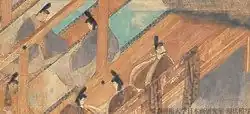笛
| ||||||||
Translingual
Han character
笛 (Kangxi radical 118, 竹+5, 11 strokes, cangjie input 竹中田 (HLW), four-corner 88603, composition ⿰𥫗由)
References
- KangXi: page 879, character 33
- Dai Kanwa Jiten: character 25917
- Dae Jaweon: page 1307, character 23
- Hanyu Da Zidian (first edition): volume 5, page 2955, character 1
- Unihan data for U+7B1B
Chinese
| trad. | 笛 | |
|---|---|---|
| simp. # | 笛 | |
| alternative forms | 篴 | |
Glyph origin
Characters in the same phonetic series (由) (Zhengzhang, 2003)
| Old Chinese | |
|---|---|
| 袖 | *ljɯwɢs |
| 岫 | *ljɯwɢs |
| 牰 | *ljɯwɢs, *lɯwɢs |
| 抽 | *l̥ʰɯw |
| 妯 | *l̥ʰɯw, *l'ɯwɢ |
| 紬 | *l'ɯw |
| 怞 | *l'ɯw |
| 鮋 | *l'ɯw, *ɦljɯw, *lɯw |
| 菗 | *rlɯw |
| 宙 | *l'ɯwɢs |
| 胄 | *l'ɯwɢs |
| 冑 | *l'ɯwɢs |
| 伷 | *l'ɯwɢs |
| 駎 | *l'ɯwɢs |
| 油 | *lɯw, *lɯwɢs |
| 由 | *lɯw |
| 蚰 | *lɯw |
| 秞 | *lɯw |
| 邮 | *lɯw |
| 釉 | *lɯwɢs |
| 柚 | *lɯwɢs, *l'ɯwɢ |
| 鼬 | *lɯwɢs |
| 苖 | *l'ɯːwɢ, *l̥ʰɯwɢ |
| 笛 | *l'ɯːwɢ |
| 迪 | *l'ɯːwɢ |
| 頔 | *l'ɯːwɢ |
| 軸 | *l'ɯwɢ |
| 舳 | *l'ɯwɢ |
Phono-semantic compound (形聲, OC *l'ɯːwɢ) : semantic 竹 (“bamboo”) + phonetic 由 (OC *lɯw).
Etymology
Cognate with 籥 (OC *lowɢ, “bamboo flute”) (Baxter, 1992).
Pronunciation
Synonyms
Dialectal synonyms of 笛子 (“(Chinese) transverse flute”) [map]
| Variety | Location | Words |
|---|---|---|
| Formal (Written Standard Chinese) | 笛子, 橫笛 | |
| Mandarin | Beijing | 笛子, 橫笛兒 |
| Taiwan | 笛子 | |
| Yantai (Muping) | 笛子 | |
| Luoyang | 笛子 | |
| Wanrong | 笛 | |
| Xi'an | 笛 | |
| Xining | 笛竿兒 | |
| Guiyang | 笛子 | |
| Yangzhou | 笛子 | |
| Singapore | 笛子 | |
| Cantonese | Guangzhou | 笛 |
| Hong Kong | 笛, 笛子 Chinese | |
| Gan | Nanchang | 笛子 |
| Lichuan | 笛仔 | |
| Pingxiang | 笛子 | |
| Hakka | Meixian | 笛 |
| Jin | Taiyuan | 笛子 |
| Min Nan | Xiamen | 笛仔, 𥰔仔 |
| Quanzhou | 笛仔, 𥰔仔 | |
| Zhangzhou | 𥰔仔 | |
| Tainan | 𥰔仔 | |
| Shantou | 笛 | |
| Jieyang | 笛 | |
| Wu | Suzhou | 笛 |
Compounds
Derived terms from 笛
Japanese
Readings
Etymology 1
| Kanji in this term |
|---|
| 笛 |
| ふえ Grade: 3 |
| kun’yomi |
⟨puye⟩ → */puje/ → /ɸue/ → /fue/
From Old Japanese, first cited to the Nihon Shoki of 720 CE.[1]
Noun
笛 • (fue)
Derived terms
Idioms
- 笛吹けども踊らず (fue fukedomo odorazu)
Etymology 2
| Kanji in this term |
|---|
| 笛 |
| てき Grade: 3 |
| goon |
From Middle Chinese 笛 (MC dek̚). The 漢音 (kan'on, literally “Han sound”), so likely a later borrowing.
First cited to a text from the 1400s.[1] This reading appears to have fallen out of use.
Derived terms
Noun
笛 • (teki)
Etymology 3
| Kanji in this term |
|---|
| 笛 |
| ちゃく Grade: 3 |
| kan’yōon |
From a corruption of Middle Chinese 笛 (MC dek̚).
First cited to a text from 1241.[1]
Korean
Hanja
笛 • (jeok) (hangeul 적, revised jeok, McCune–Reischauer chŏk, Yale cek)
- This term needs a translation to English. Please help out and add a translation, then remove the text
{{rfdef}}.
Vietnamese
This article is issued from Wiktionary. The text is licensed under Creative Commons - Attribution - Sharealike. Additional terms may apply for the media files.
